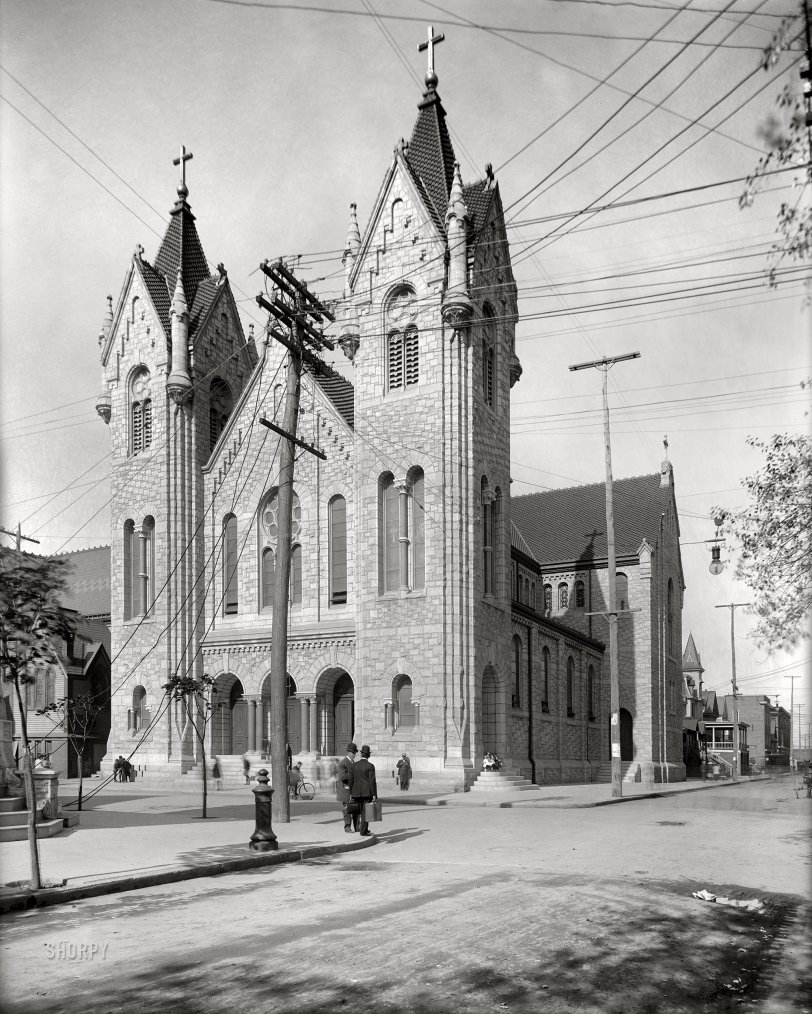


Framed or unframed, desk size to sofa size, printed by us in Arizona and Alabama since 2007. Explore now.
Shorpy is funded by you. Patreon contributors get an ad-free experience.
Learn more.

- Baldwin 62303
- Baldwin VO-1000
- Cold
- No expense spared
- Tough Guys
- Lost in Toyland
- And without gloves
- If I were a blindfolded time traveler
- Smoke Consumer Also Cooks
- Oh that stove!
- Possibly still there?
- What?!?
- $100 Reward
- Freeze Frame
- Texas Flyer wanted
- Just a Year Too Soon
- WWII -- Replacing men with women at the railroad crossing.
- Yes, Icing
- You kids drive me nuts!
- NOT An Easy Job
- I wonder
- Just add window boxes
- Icing Platform?
- Indiana Harbor Belt abides
- Freezing haze
- Corrections (for those who care)
- C&NW at Nelson
- Fallen Flags
- A dangerous job made worse
- Water Stop
Print Emporium
Atlantic & Pacific: 1907

Atlantic City, New Jersey, circa 1907. "St. Nicholas Church, Pacific and Tennessee Avenues." 8x10 inch dry plate glass negative, Detroit Publishing Company. View full size.
In reply to Rob Ellie
Carbon rods, positive and negative or sometimes two negatives, were used in projection world wide up until around the 1960s when xenon filled high pressure glass bulbs were introduced. Both consumed large amperage but at low voltages, based on the size of the rectifiers supplying the DC current, the size of the screen, and the size of the carbon rods and xenon lamps, ranging anywhere from 5mm to 30mm diameter or more for the carbon rods to 1000 watts to 15000 watts for xenons, depending on whether the screen was small or huge such as Imax. The latest technology is laser powered light sources in some locations. The xenon lamps are used for both film (now rare) and digital projection.
Carbon arcs were also the norm for film studio lighting, in combination with sealed lamps. Carbon arc light was very intense, needed especially for early slow speed film stock. It was also the closest natural color temperature to daylight.
Film spools were usually around 1000 feet in the era of flammable nitrate film and then when safety film was developed around the early 1950s, 2000 feet became the industry norm for shipping and most projection, until larger spools, example 6000 feet started being used in some cinemas in the 1960s, leading to the entire film (35mm or 70mm) being held on horizontal 'platters' introduced around the early 1980s, all systems that were joined up by the projectionist from the delivered 2000 foot spool. A 2000 foot spool ran for about 20 minutes when full.
Then and Now
Looking at the magnificent structure in 1907, one is aware of its huge size, and with the spartan number of people around makes it seem even more huge and out of sync with reality. Skip forward to 2021 and it seems not many more people are around than 114 years before.
What were they looking at?
The St. Nicholas of Tolentine Catholic Church, circa 1907, is a beautiful church. But I wonder what parish it serves? Today it's surrounded by mostly low price hotels and parking lots.
This picture captures some great moments. At left is a group of boys, circled around something, all staring down intently. No doubt it was something only boys would find fascinating. While around the corner are the girls, grouped at the top of the steps. You can almost hear the giggling. I also like the man up against the wall, with his thumbs in his vest, posing for the photographer.
Quite the tangle
Power line work by the local electric company has left the top of this utility pole looking like the aftermath of an explosion in a spaghetti factory.
The carbon arc light suspended above the street brings back memories of the old movie projectors. For a couple of summers during my adolescence I was friends with the projectionist at one of the local drive-in theaters. I would go to work with him different nights and learned to operate the projectors. One of the neat things was watching for the little circle of light to flash on the bottom right of the screen to signal when to start the second projector. When the circle flashed again you opened the shutter on the second projector and shut off the first projector. If done correctly it was seamless. I don't remember exactly long each reel of film lasted but there were a lot changes in a two hour movie. Add that to the standard double feature starting about nine o'clock and you had yourself a hot summer night.
Now I've Robert Palmer and those girls in my head.
Fresh Ground
It would be holy [sic] appropriate, then, if the post-service convivium featured refreshment made possible by a classic A&P Eight O'Clock coffee grinder (the sort of which was omnipresent in grocery stores of the not-so-distant past).
Ground for this church was broken not so very long before this image was captured, as construction was completed in 1905. And it still stands! (I was prepared to discover this would be yet another church to face the wrecking ball.)
Not on my Monopoly board
Having visited Atlantic City but once, it is difficult for me to think of it as a normal town with churches and grocery stores and such. I don’t remember Boardwalk Empire as being heavily populated by the “normal” either!
Now if the spires displayed gold letters spelling
T
R
U
M
P ....
Reprobates?
Based on my own misspent youth, it appears those boys to the left of the church are up to no good.
























On Shorpy:
Today’s Top 5